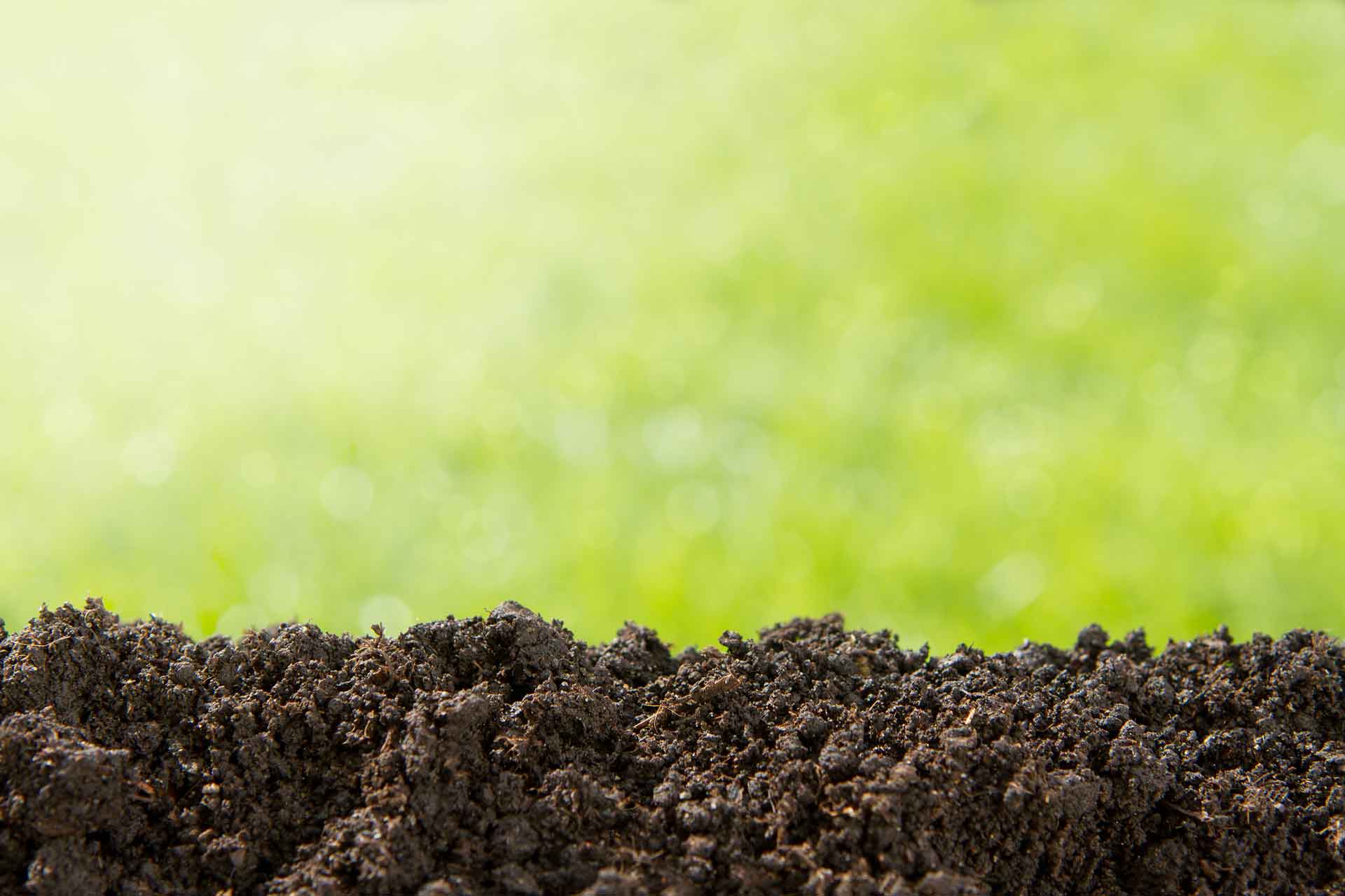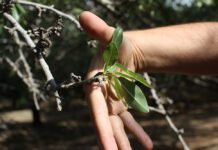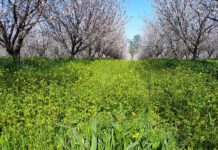Specialists rattle off chemistry terms, percentages, and solubility, and while it’s all extremely important information in regards to the health of your orchard, this knowledge becomes useless without the help of the most vital component:
Water.
Richard Kreps, CCA stressed water importance earlier this summer at the Mid Valley Nut Expo in Turlock, California, and it’s no secret that nutrition management comes down to the barest of basics for healthy trees and thriving orchards. But, are your trees drawing water from the depths they should be? What do you do as the season progresses?
Ideally, your water is reaching down to the four-to-five foot level after the rains and spring begins. Unless your cation-exchange capacity (CEC) are five or less—which is practically river sand—you’re not going to get water down deep when the heat turns up. As such, your trees will not have available water to draw from at those depths.
If you’ve missed your opportunity for watering deep, the primary focus must shift to watering primarily in the feeder rootzone, fertigating there, and adding nutrition via the foliage.
Deep Moisture vs. Rootzone
Let’s just say it’s a little late in the season, and you weren’t able to get water down to the four- and five-foot levels prior to the weather becoming warm. Are you in trouble?
It’s a common question and a valid concern. Since the trees are unable to pull from that depth now, the concentration of watering should be at the rootzone in order to keep the tree hydrated and prevent it from stressing. But care must be taken to reduce the time of irrigation sets and increase the frequency. You want the saturation level to fluctuate and not become anaerobic. Drowning your feeder roots will not do you any favors.
Know Your Soil
Knowing your soil type is a grower’s mantra and primary rule. Moisture sensors can provide a lot of information, and if you’re using probes, it’s important to check multiple locations around the orchard for the field saturation percentages. If your budget limits the use of sensors, grab a shovel and hit the dirt.
A crucial element to knowing your soil is knowing your water. How many gallons per minute (gpm) is your well putting out? How long does it take for the water to reach a certain level in your soil? How long is available moisture lasting?
With a typical sand profile, water goes out about a foot on each side of the emitter or sprinkler pattern, and can get down about six feet in 24 hours. For most of the nut growers in California’s Central Valley, it’s going to take much longer to penetrate those depths. Clay soils will take much longer. A common mistake is applying more water, which becomes more than the tree can handle, and can send it into anaerobic mode.
Knowing your perched water tables, clay lenses, and other factors that determine how quickly your water moves can tell you how much and how often to water. Don’t let the soil around the roots become anaerobic. If this happens, and the tree does indeed go without oxygen for too long, the roots won’t be able to function, and the evapotranspiration (ET) rate will slow down significantly. The trees can wilt because they aren’t pulling what they need from the soil. When the tree wilts, growers might think the tree isn’t getting enough water, and the damaging cycle begins.
This also means that now the tree is drying out even slower because it has gone anaerobic.
The speed at which your water moves can also determine if you need to bump up the number of applications you do per week, but have less water per application. This is often a better and more effective way to irrigate and still try to keep the tree out of anaerobic mode.
So flush and dry down, flush and dry down, keeping ET rates optimal, the water in the rootzone, and the trees able to absorb nutrients.
Get It Down
Soluble cations are the best bet for getting what you need into the dirt and into the trees. While the industry norm touts the benefits and ease of gypsum, calcium sulfate has a very low solubility, no matter how fine the material is.
If you put one ton of gypsum on your trees at about 25 percent calcium and ¼ of one percent solubility, of that 2,000 pounds, you’re really only getting about a pound-and-a-half of soluble calcium, which makes assimilating nutrients a fruitless and expensive endeavor. Also, if the nutrient is just being distributed on top of the soil, it’s an even greater disservice to the health of the trees, as well as your wallet. The nutrient needs to get underneath the ground and be worked into the soil, where calcium can be more useful in getting water down.
For those who are chasing nitrogen, calcium nitrates may be a better solution, along with other, more soluble calcium products. Calcium thiosulfate is also an option because it is 100 percent soluble. If using sulfate of potash, there’s only about a seven percent solubility with that salt. It’s another material that needs to be worked into the soil to become more available in the rootzone, instead of just broadcasting the nutrient over the top.
Fulvic and humic acids can be great aids in getting nutrients into your trees. While the state of California doesn’t allow the listing of how much fulvic acid is present in a product, your product representatives should be able to tell you the humic acid percentages. This carbon-based acid is reported to absorb 20x its weight in water—a helpful and welcome advantage for thirsty trees.
Know with Samples
Even though the old University of California recommendations were to take soil samples every three years, it’s becoming the norm—and highly recommended—to take soil samples annually. Samples are generally taken sometime in March, after the rains have come and gone, so that the samples can show which nutrients have been flushed from your orchard.
Good soil samples are best complemented by multiple tissue samples throughout the season. Knowing how the nutrients you are applying are reacting with one another is key in knowing what to apply and when. This prevents blanket applications of nutrients that are either going unused, or being tied up because of an overabundance of another nutrient
As growers know, orchard nutrition is not cheap. The perks of soil and tissue samples are two-fold: your trees stay healthy, and more of your money stays in your pocket. After all, it doesn’t make much sense to throw nutrients into the orchard if you’re actually hindering its ability for it to go into the plant.
A typical soil sample will have your cations: calcium, magnesium, potassium, and sodium. There are typical guidelines for ratios and percentages that align with these nutrients. But what isn’t often discussed is total load.
If the calcium in your orchard is 1,000 parts per million (ppm) and the neighboring orchard is 4,000 ppm, the percentages of nutrients in each can be exactly the same, say 65 percent. However, the 4,000 ppm soil will have a lot more calcium that could become available to you. Water extractions are important for this reason—they tell you what’s in the water, and the equivalence of specific nutrients/cations that are coming out of your water.
Above and Below
While it may seem like a lot or an involved process to keep an eye on the nutritional goings on of your orchard, it really comes down to making sure you have healthy and balanced trees. Trees operating in optimal health have a lot less disease, heat stress, and pest pressure.
Macronutrients—such as nitrogen, phosphorus, calcium, potassium, magnesium, sulfur—take priority when it comes to establishing balance. This way, the tree has the bulk of the nutrients it needs to function while you begin assimilating and adjusting the micronutrients.
It’s a nutrient-by-nutrient process, meaning a triple mix or a micronutrient package isn’t always the best idea. High aluminum could be blocking the phosphate absorption. Phosphate and calcium can’t usually run together. So, what do you do if you need multiple nutrients that don’t necessarily work with each other for absorption?
Apply one to the soil through fertigation, and one to the leaves in a foliar spray.
Your consultants should advise you on how to get the best results—and the best bang for your buck—when applying nutrients. Some nutrients absorb better in foliar applications. It’s possible a gallon in the ground could be the equivalent of a pint or quart if you apply to the foliage—and with better absorption rates—so ask what would be best for your specific plot.
If fertigation isn’t working, the weaker nutrients can be used in a foliar spray and the adjustments can be made up top. Over application of one nutrient can definitely block another’s efficacy. For example, soils with 30-40 percent base saturation magnesium, may have 5,000 ppm of calcium present, but the calcium isn’t making it into the plant. With magnesium being a double charge and smaller than calcium, it’s actually competing harder than the calcium, potassium, and sodium to get absorbed into the tree. This could be great in terms of sodium, but bad news in terms of potassium and calcium. Foliar nutrition applications could be a better option.
Postharvest Reboot
All permanent crops need postharvest nutrition. Postharvest nutrition is absolutely critical to the recovery of orchards, and this concept hasn’t received enough attention or emphasis in the last two-to-three decades. The industry is confirming that getting the trees back to where they need to be is one of the most beneficial things a grower can do postharvest to ensure the health of next season’s crop.
This is seen significantly with phosphorus. When the weather is cold and rainy, you’re not going to get much phosphorus out of the soil, and that is the plant’s critical energy-producing nutrient. Getting phosphorus into your trees early is necessary to avoid yield loss.
What has become normal practice is applying a mix that’s heavy in phosphate. Many of these mixes are higher in polyphosphate percentages. But, polyphosphate takes an exceptionally long time to break down in the soil in the colder and wetter months like spring (100 days), versus the hotter months (four days), delaying or preventing any uptake by the roots. Because polyphosphate breaks down quickly in the heat, you can get more availability in the fall. An orthophosphate source (the form a plant can drink at the actual time of application) may be a better option, but take caution. Over application of phosphorus can significantly block calcium and magnesium from being available to the roots. Load your trees with the energy they need for next spring. It will be worth it.
While growers recover from harvest season, so do orchards. Rehydrate the trees with good water so they can assimilate nutrition. Concentrate first on the top six nutrients, and then get the ten micronutrients back to the optimal levels they had in July. Postharvest demand will put plenty back into the roots, and stored carbohydrates will be great for next year’s push. Trees need to be happy when they become dormant until next season, and caring for them properly now will ensure a better crop next year.
Special thanks to Richard Kreps, CCA, SSp #371469. rkreps@ultragro.net
















